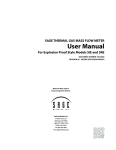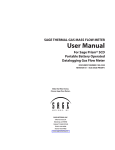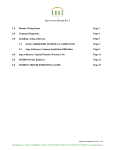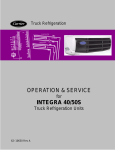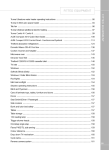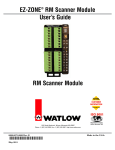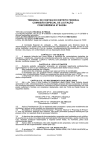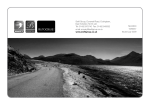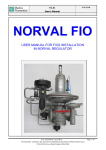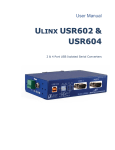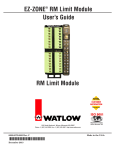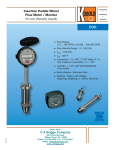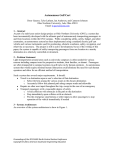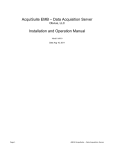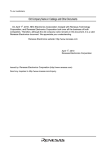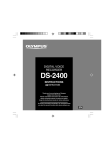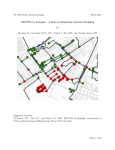Download Thermal Mass Flow Meter Manual for Sage 100 -200-300
Transcript
SAGE THERMAL GAS MASS FLOW METER User Manual 100/200/300 Series DOCUMENT NUMBER 100-0316 Make the Wise Choice. Choose Sage Flow Meters. SAGE METERING, INC. 8 Harris Court, D1 Monterey, CA 93940 1-866-677-SAGE (7243) Tel 831-242-2030 Fax 831-655-4965 www.sagemetering.com User Manual SAGE METERING, INC. 3 Table of Contents Introduction Welcome . . . . . . . . . . . . . . . . . . . . . . . . . . . . . . . . . . . . . . . . . . . . . . . . . . . . . . . 5 SECTION A Getting Started Unpacking Your Sage Meter . . . . . . . . . . . . . . . . . . . . . . . . . . . . . . . . . . . . . . . . 9 Maintenance . . . . . . . . . . . . . . . . . . . . . . . . . . . . . . . . . . . . . . . . . . . . . . . . . . . 9 Calibration . . . . . . . . . . . . . . . . . . . . . . . . . . . . . . . . . . . . . . . . . . . . . . . . . . . . . 9 Installation and Mounting . . . . . . . . . . . . . . . . . . . . . . . . . . . . . . . . . . . . . . . . . 10 Locating Proper Wiring Diagram . . . . . . . . . . . . . . . . . . . . . . . . . . . . . . . . . . . . 10 Insertion Flow Meter Application. . . . . . . . . . . . . . . . . . . . . . . . . . . . . . . . . . . . 11 Sage Valve Assembly Operation . . . . . . . . . . . . . . . . . . . . . . . . . . . . . . . . . . . . . 11 Flow Conditioning and Straight Run . . . . . . . . . . . . . . . . . . . . . . . . . . . . . . . . . 11 Compression Fitting Operation . . . . . . . . . . . . . . . . . . . . . . . . . . . . . . . . . . . . . 12 Installation Instructions . . . . . . . . . . . . . . . . . . . . . . . . . . . . . . . . . . . . . . . . . . . 12 Captive Flow Conditioners . . . . . . . . . . . . . . . . . . . . . . . . . . . . . . . . . . . . . . . . . 13 Probe Insertion Guideline Drawing . . . . . . . . . . . . . . . . . . . . . . . . . . . . . . . . . . 14 Installation Depth Chart . . . . . . . . . . . . . . . . . . . . . . . . . . . . . . . . . . . . . . . . . . 15 Large Duct or Stack Applications . . . . . . . . . . . . . . . . . . . . . . . . . . . . . . . . . . . . 16 In-line Flow Meter Application . . . . . . . . . . . . . . . . . . . . . . . . . . . . . . . . . . . . . 17 Electric Wiring. . . . . . . . . . . . . . . . . . . . . . . . . . . . . . . . . . . . . . . . . . . . . . . . . . . 18 Output Wiring. . . . . . . . . . . . . . . . . . . . . . . . . . . . . . . . . . . . . . . . . . . . . . . . . . . 19 SECTION B Styles & Features Principle of Operation . . . . . . . . . . . . . . . . . . . . . . . . . . . . . . . . . . . . . . . . . . . . 25 Features and Benefits . . . . . . . . . . . . . . . . . . . . . . . . . . . . . . . . . . . . . . . . . . . . . 26 Styles & Specifications . . . . . . . . . . . . . . . . . . . . . . . . . . . . . . . . . . . . . . . . . . . . 27 Sage Display . . . . . . . . . . . . . . . . . . . . . . . . . . . . . . . . . . . . . . . . . . . . . . . . . . . . 28 Approvals. . . . . . . . . . . . . . . . . . . . . . . . . . . . . . . . . . . . . . . . . . . . . . . . . . . . . . . 29 SECTION C Drawings Integral Style Flow Meters. . . . . . . . . . . . . . . . . . . . . . . . . . . . . . . . . . . . . . . . . . 33 Remote Style Flow Meters. . . . . . . . . . . . . . . . . . . . . . . . . . . . . . . . . . . . . . . . . . 34 Remote Bracket Layout . . . . . . . . . . . . . . . . . . . . . . . . . . . . . . . . . . . . . . . . . . . . 35 Mounting Hardware: SVA05 Series Isolation Valve Assembly for Insertion Meters . . . . . . . . . . . . 36 STCF Series Teflon Ferrule Compression Fitting . . . . . . . . . . . . . . . . . . . . . . 36 SVA05 Series Isolation Valve Assembly Detail . . . . . . . . . . . . . . . . . . . . . . . . 36 Mounting Plate for Thin Walled Ducts . . . . . . . . . . . . . . . . . . . . . . . . . . . . . 36 SVA05LP Low Pressure Isolation Valve Assembly. . . . . . . . . . . . . . . . . . . . . . . . 37 In-Line and Insertion Flanges. . . . . . . . . . . . . . . . . . . . . . . . . . . . . . . . . . . . . . . 38 SECTION D Diagnostics Common Diagnostics . . . . . . . . . . . . . . . . . . . . . . . . . . . . . . . . . . . . . . . . . . . . . 41 continued on next page REV. 1-0215 4 SAGE METERING, INC. SECTION E Warranties and Service Work User Manual Limited Warranty . . . . . . . . . . . . . . . . . . . . . . . . . . . . . . . . . . . . . . . . . . . . . . . . 47 Cancellation/Return Policy. . . . . . . . . . . . . . . . . . . . . . . . . . . . . . . . . . . . . . . . . 47 Returning Your Sage Flow Meter . . . . . . . . . . . . . . . . . . . . . . . . . . . . . . . . . . . . 49 Return Material Authorization Form . . . . . . . . . . . . . . . . . . . . . . . . . . . . . . . . . 50 SECTION F Modbus Modbus Register Listing . . . . . . . . . . . . . . . . . . . . . . . . . . . . . . . . . . . . . . . . . . . 53 Modbus Protocol & Function Codes . . . . . . . . . . . . . . . . . . . . . . . . . . . . . . . . . 54 Sage Register Output Format . . . . . . . . . . . . . . . . . . . . . . . . . . . . . . . . . . . . . . . 58 Sage Addresser Software . . . . . . . . . . . . . . . . . . . . . . . . . . . . . . . . . . . . . . . . . . . 58 Sage Addresser Typical Printout (Version 3.14) . . . . . . . . . . . . . . . . . . . . . . . . . 59 SECTION G Appendix Sage Service Department “Dongle” . . . . . . . . . . . . . . . . . . . . . . . . . . . . . . . . . . 63 Correction Factors For Varying Gas Mixes . . . . . . . . . . . . . . . . . . . . . . . . . . . . . 64 Installations Where Pipe Condensation May Develop . . . . . . . . . . . . . . . . . . . 64 J-Box and Upstream Orientation . . . . . . . . . . . . . . . . . . . . . . . . . . . . . . . . . . . . 65 What Is a Thermal Mass Flow Meter? . . . . . . . . . . . . . . . . . . . . . . . . . . . . . . . . 66 REV. 1-0215 User Manual SAGE METERING, INC. 5 Welcome We are pleased that you have purchased a Sage Metering Mass Flow Meter for your requirement. We hope that you are satisfied with the performance, operation and design of our highly precise, NIST traceable Thermal Gas Mass Flow Meter. Sage Metering is your source for monitoring, measuring and controlling the gas mass flow in your industrial process, building management system or environmental application. Our high performance, NIST Traceable,Thermal Mass Flow Meters will help increase productivity, reduce energy costs, maximize product yields, and/ or help reduce environmental insult. Sage provides high quality In-Line and Insertion Thermal Mass Flow Meters for a wide variety of industrial, commercial, and environmental monitoring needs, including carbon credit verification for Greenhouse Gas reduction. Sage Meters measure mass flow directly — there is no need for ancillary instrumentation such as temperature or pressure transmitters. Furthermore, our instruments have exceptional signal sensitivity, have no moving parts, require little if any maintenance, have negligible pressure drop and have a turndown up to 100 to 1, and resolve as much as 1000 to 1. Sage Flow Meters can measure the mass flow rate and consumption of air, oxygen, natural gas, nitrogen, digester gas, biogas, flare gas, hydrogen, argon, carbon dioxide and other gases and gas mixes. The Sage 100/200/300 family of thermal mass flow meters is an addition to the wellknown Sage Prime. These products provide the same performance as the Prime with fewer features and less functionality at a more economical pricing. The 100 is the basic integral design without display. The 200 and 300 Series are available with and without display and with integral and remote electronics. The display provides a reading of the flow rate, total flow, and gas temperature. The 300 series is intended for use by customers in the United States and Canada with the 200 series used for international customers. The following table lists the various model combinations: DISPLAY INTEGRAL/REMOTE ELECTRONICS 111 No Integral 201/301 Yes Integral 202/302 Yes Remote 211/311 No Integral 212/312 No Remote All units provide a 4-20 mA and a pulse signal. Modbus RS485 RTU is optionally available. The 200 and 300 series use either 24 VDC or 115/230 VAC input power while the 100 Series is only 24VDC. REV. 1-0215 6 SAGE METERING, INC. Please let us know if we can assist you in any way with your Sage Meter, or if you have any questions about its installation, operation, or features. Simply phone us at 866-677-SAGE (7243), or visit our website at www.sagemetering.com to contact a factory representative in your area. This manual is available on the website under Knowledge Base section. Sincerely, Robert Steinberg President REV. 1-0215 User Manual Section A GETTING STARTED User Manual SAGE METERING, INC. 9 Getting Started UNPACKING YOUR SAGE METER buildup may be required. A soft brush can be used to gently clean the sensing element’s surface, using Your Sage flow meter is a sensitive, yet rugged, caution to avoid damaging the sensor elements precision built electronic instrument. Upon delivery, (the RTDs). If any disassembly is necessary, contact care should be taken when opening the shipping Sage Metering, Inc. for instructions. In general, it is container and removing your meter. The meter recommended that your Sage Thermal Mass Flow should be inspected for any damage that may have Meter be returned to the factory if cleaning, occurred during transit. If damage is found, please repair, or recalibration is needed. This is usually contact the carrier immediately to place a claim for the most cost-effective and reliable alternative. damaged goods. The contents of the container should be checked against the packing list for any CALIBRATION discrepancies. If there are any questions as to the contents or configuration of the equipment includ- Each flow meter is individually calibrated for the ing calibration ranges, or, mounting hardware, specified gas and flow rate specified on the applica- contact Sage Metering as soon as possible. Please tion sheet submitted with each order. The unit is save shipping container and packaging materials factory configured for the process and installation (including PVC tube probe protector on Sage parameters. A Certificate of Conformation is includ- Insertion Flow Meters) in case the unit needs to ed with each unit. be returned for any reason. MAINTENANCE Sage thermal mass flow meters essentially require little or no maintenance. While the sensing element is somewhat resistant to dirt and particulate build up, it may become necessary to clean it from time to time if mounted in extremely dirty environments. NOTE: ALWAYS REMOVE THE POWER PRIOR TO ANY CLEANING OR MAINTENANCE. A detergent or appropriate non-corrosive solvent for removing the a a a CAUTION cable glands shipped with unit are for shipping purposes only. Remove shipping cable glands before installing. CAUTION If installing in a Class I hazardous location the installation must comply with appropriate electrical codes. CAUTION Installer must supply proper ground and bond wire for the transmitter and the sensor per appropriate electrical codes REV. 1-0215 10 User Manual SAGE METERING, INC. INSTALLATION AND MOUNTING The EN 60079-14 must be considered LOCATING PROPER WIRING DIAGRAM See pages 18–22 for electrical wiring of the Sage ■ Check the Certificate of Conformance included Prime. There is an illustration in the electronics with your Sage Thermal Mass Flow Meter for cover which shows wiring connections. system pressure, temperature, gas composition, power input, and signal output. ■ See page 18 for a wiring diagram of the DC or AC It is recommended that the flow meter be inserted in input power. Page 19 and 20 give wiring connec- a location of maximum straight run. It is suggested tions for the output signals. For units with remote that there be a minimum of 15 pipe diameters of electronics, the wiring in the electronics enclosure straight run upstream, and 5 diameters downstream, is made at Sage Metering; page 21 gives wiring illus- depending on the conditions. See chart on page 11. tration for wiring the cable at the remote terminal Note, obstructions such as valves, blowers, expand- enclosure. ers and PVC and HDPE pipes will require additional straight run (contact factory for assistance). ■ Note: Do not open the display side of the enclosure. Check the orientation1: Standard calibration flow direction is left to right when facing the flow meter. Gas flow direction is marked with an arrow on in-line flow meters; UPSTREAM is marked on insertion probes. ■ Do not rotate probe1, or errors may occur. If enclosure is facing incorrectly, rotate the enclosure 180˚, but do not rotate the probe. The UPSTREAM mark still needs to be facing Upstream. ■ Hook up the system per the wiring diagram provided with your Sage flow meter (see inside of rear compartment cover for terminal designation). Double check that wiring for the proper power and signal connections are correct. ■ Check that all plumbing and electrical hook-ups are in accordance with OSHA, NFPA, and all other safety requirements. ■ For Remote Style Meters be sure the Remote Electronics is matched with the Transmitter’s Junction Box and its attached Probe or Flow Body. There will be Metal Serial Number Tags on both the Transmitter as well as the Remote Electronics enclosure. Do not mismatch the serial numbers of the Remote Electronics and the Junction Box, or calibration errors will occur. REV. 1-0215 1 The Integral Style Insertion Meters have the Display oriented as shown on page 14. If an alternate orientation of the display, or enclosure is required (ie. installation into a vertical pipe), please furnish a sketch or drawing, and specify “ROTATE” on purchase order. However, if it is later determined that the enclosure needs to be rotated, that procedure can be done in the field. However, if the display needs to be rotated, then the meter must be sent back to Sage to be modified. Do not attempt this in the field. An RMA will be required prior to returning the meter (see page 50). The procedure for rotating the enclosure is as follows: Clamp the enclosure in a vise with the probe pointing up to the ceiling. Then take a 7/8 wrench and turn the probe to the proper orientation. Lock the probe into its new position with a set screw (not provided). User Manual SAGE METERING, INC. 11 Insertion Flow Meter Application FLOW PROFILE AND INSTALLATION CONSIDERATIONS Insertion Flow Meters, although generally easier to install that In-Line Flow Meters, require proper installation, and a well developed flow profile, in order to perform properly. Please refer to the section on the following pages titled PROBE INSERTION GUIDELINE DRAWING (page 14) and INSTALLATION DEPTH CHART (page 15). insertion probe will be inserted. Avoid T-Fittings since they will disturb the flow profile, and effectively reduce the measurement area. Direct threading together (or with necessary bushings) of the retractor assembly may be required. In other cases, the threadolet must be welded in place and a clearance hole must be drilled through the pipe/ duct to accept the probe assembly. If the pipe/duct is under pressure during installation, a hot tap drill (not available through Sage Metering) may be required. SAGE VALVE ASSEMBLY OPERATION Valve assemblies (SVA05 and SVA05LP) are an optional mounting hardware for Insertion Style Flow Meters (see pages 36 and 37). They allow the removal of insertion-style meters for service, cleaning, recalibration, relocation, etc. without the need to “shutdown” your process. The probe insertion depth is adjustable to permit sensor to be located at center to optimize measurement accuracy. (Refer to PROBE INSERTION GUIDELINE DRAWING and CHART, pages 14 & 15.) The ball valve will seal off leaks of the process gas at the point of insertion after the probe assembly has been removed. The assembly includes FLOW CONDITIONING AND STRAIGHT RUN Although a minimum of 15 pipe diameters of upstream straight run is commonly recommended, to absolutely assure that the flow profile is well developed at the point of measurement, either use Flow Conditioners (standard in Sage In-Line Flow Meters, 1/2" and larger, and also available as assemblies for Insertion Flow Meters, see page 13), or consider additional straight run. The Chart below provides examples of the amount of straight run that would virtually assure that there are no flow disturbances at the point of measurement. a valve, threadolet, compression fitting with Teflon ferrule, a cable restraint, and two collar clamps. IMPORTANCE OF FLOW CONDITIONING Recommended Pipe Diameters Upstream A threaded half coupling (3/4" FNPT) properly sized to accommodate the isolation valve retractor assem- WITHOUT FLOW CONDITIONING WITH FLOW CONDITIONING1 Minimum Industry Recommendation Sage Recommendation One 90˚ Elbow 15 3 Two 90˚ Elbows in the same plane 20 5 Two 90˚ Elbows in different planes At least 40 9 4:1 Area Reduction 15 3 4:1 Area Expansion At least 30 10 Multiple Disturbance To Be Determined TBD DISTURBANCE bly must be fitted to the pipe/duct to which the NOTE: Detailed Drawings are shown on pages 36 & 37. 1 This column applies to In-Line Flow Meters, which come standard with built-in Flow Conditioners, as well as Insertion Meters, when provided with upstream Captive Flow Conditioners (see page 13). REV. 1-0215 12 User Manual SAGE METERING, INC. COMPRESSION FITTING OPERATION INSTALLATION INSTRUCTIONS A bored through tube fitting, properly sized to 1. Insert tubing into the tube fitting. accommodate an insertion probe’s particular OD, can be provided by the user or purchased as an option from Sage Metering (see page 36). Prior to installation, a clearance hole to accommodate the insertion probe assembly must be drilled in the 2. Make sure that the tubing is positioned properly per the PROBE INSERTION GUIDELINE DRAWING AND CHART, pages 14 & 15. 3. Due to the variations of tubing diameters, a pipe/duct. A fitting (1/2" FNPT) is then welded in common starting point is desirable. Therefore, place or threaded into the half-threadolet which has tighten the nut until the tubing will not turn been welded to the pipe/duct. The probe insertion by hand or move axially in the fitting. depth is adjustable to permit sensor to be located at 4. Scribe the nut at the 6 o’clock position. center, to optimize measurement accuracy. (Refer to PROBE INSERTION GUIDELINE DRAWING and CHART, pages 14 & 15.) 5. While holding fitting body steady, tighten the nut 11⁄4 turns to the 9 o’clock position. Insert the probe shaft tubing into the compression fitting to the position indicated in the Probe Insertion guidelines. While holding the fitting body steady, tighten the nut one and one-quarter turns to the 9 o’clock position. REV. 1-0215 User Manual SAGE METERING, INC. CAPTIVE FLOW CONDITIONERS Can Be Installed in Conjunction with Insertion Style Flow Meters IMPORTANT The location of the probe must be exactly one pipe ID diameter (i.e., 4” in a 4” pipe; 6” in a 6” pipe, etc.) downstream of the Captive Flow Conditioning assembly. The Captive Flow Conditioners are always designed to be separated by one pipe diameter. See drawing below. The probe location must be one pipe ID diameter downstream of Flow Conditioner, or errors will occur. Front View of one of the Conditioning Plates One Pipe Diameter Note: See table on page 11 (last Column) for Straight Run Requirement Largest of the Two Perforated Plates Straight Run Requirement from this Flange One Pipe Diameter FLOW ANSI Class Flanges (user supplied) Flow Conditioning Assembly is inserted here. NOTE: The larger of the two perforated plates of the Sage Flow Conditioning assembly is positioned between two flanges and two gaskets as shown. The smaller of the two perforated plates of the conditioner will freely slide into the application pipe, facing downstream. The probe mounting hardware will be placed one diameter downstream of the downstream plate. Probe location must be one pipe ID diameter downstream of Flow Conditioners or errors will occur. Gaskets 13 14 User Manual SAGE METERING, INC. PROBE INSERTION GUIDELINE DRAWING1 Sage insertion style flow meters can be assembled and calibrated for use in virtually any size pipe or Choose the longest straight-run section of pipe available to allow a uniform, well-developed flow profile. Allow for a minimum of 15 pipe diameters of straight run upstream, and 5 diameters downstream, depending on the conditions. See chart on page 11. Note, obstructions such as valves, blowers expanders and PVC and HDPE pipes will require additional straight run (contact factory for assistance). Avoid, if possible, installations immediately downstream of bends, fans, nozzles, heaters and especially valves, or anything else installed in the line that may cause nonuniform flow profiles and swirls. Otherwise signal output duct (as small as 1”). Sage insertion flow meters include a probe assembly that supports the sensing element (a self-heated flow sensor and a temperature/reference sensor); a sensor drive circuit; microprocessor meter board, and transmitter enclosure. The probe assembly must be inserted into the correct position in the process gas flow conduit to allow the gas to flow through the sensor “window” across the sensor element. The “sensing point” or active part of the sensor (0.5" from the end of the probe) should be positioned as per the drawing below and the Installation Depth Chart on page 15. errors could result, unless significantly more straight run is provided, or in the absence of sufficient straight run, Flow Conditioners (page 13) are installed (contact Sage for assistance if needed). Refer to page 13 to see the benefits of incorporating Flow Conditioners. Installation Depth The center of the pipe (assuming a well developed turbulent flow profile) is fairly flat, and easy to locate. See “Installation Depth Chart” on next page to determine proper insertion depth. Insertion styles are available through Sage Metering, Inc. with a standard 1/2" OD probe support assembly; 3/4" is also available. Standard probe lengths are 6", 12", 15", 18", 24", 30", 36" and 48". A common method of mounting the probe assembly through a pipe wall or duct (if ambient air) is with a compression fitting (STCF05). A Sage valve assembly (SVA05) is useful and highly recommended for pressurized applications or other gases, such as Natural Gas. Flange mounting Z is optionally available. 4" PIPE SHOWN Y Center of Pipe X REV. 1-0215 LESS THAN IDEAL LOCATION GOOD LOCATION2,3 Contact Factory for Assistance (See Installation Depth Chart for X and Y Dimension) 1. Industrial Meter shown in drawing. Note, probe is not bi-directional. 2. Probe should be inserted per Installation Depth Chart (see following page), so sensors are in the center of the pipe. 3. The portion of the probe that remains outside of the pipe, is simply the factory ordered probe length (i.e. “-15” = 15 inches) minus the “Y” dimension. User Manual SAGE METERING, INC. 15 INSTALLATION DEPTH CHART Methods for Probe Insertion to Pipe Center METHOD 1 METHOD 2 Using charts below, select pipe size (column 1), Using charts below1, select pipe size (column 1), determine X. Insert probe until the end touches the determine Y. Subtract Y from the factory supplied bottom of the pipe (ID), mark probe as it exits top probe length. That difference Z (see drawing on page of fitting. Lift probe distance “X” and tighten com- 14) should be outside of the pipe, and is measured pression fitting. from the bottom of the enclosure of the probe weld to pipe OD. 1 For other Pipe Schedules, such as Schedule 10, contact Sage, however the Y dimension will be the same for any Schedule Pipe 2 The 1" Pipe Size needs to have the Probe “Bottomed Out” (option “BOT"); the calibration method for the 11⁄2 " Pipe is either as shown below, or with option “BOT” S C H E D U L E 4 0 P I P E2 PIPE SIZE 1" OD ID X C O N S U L T SCHEDULE 80 PIPE2 Y PIPE AREA F A C T O R Y PIPE SIZE 1" OD ID X C O N S U L T Y PIPE AREA F A C T O R Y 1.5" 1.900 1.610 .20" 1.56" 0.0141 1.5" 1.900 1.500 .15" 1.56" 0.0123 2" 2.375 2.067 .40" 1.82" 0.0233 2" 2.375 1.939 .35" 1.82" 0.0205 2.5" 2.875 2.469 .60" 2.07" 0.0332 2.5" 2.875 2.323 .55" 2.07" 0.0294 3" 3.500 3.068 .90" 2.38" 0.0513 3" 3.500 2.900 .80" 2.38" 0.0459 4" 4.500 4.026 1.40" 2.86" 0.0884 4" 4.500 3.826 1.30" 2.86" 0.0798 6" 6.625 6.065 2.40" 3.95" 0.2006 6" 6.625 5.761 2.25" 3.95" 0.1810 8" 8.625 7.981 3.40" 4.90" 0.3474 8" 8.625 7.625 3.25" 4.90" 0.3171 10" 10.750 10.020 4.40" 6.00" 0.5476 10" 10.750 9.750 4.25" 6.00" 0.5185 12" 12.750 11.938 5.50" 7.00" 0.7773 12" 12.750 11.374 5.13" 7.00" 0.7056 14" 14.000 13.124 6.00" 7.50" 0.9394 14" 14.000 12.500 5.70" 7.50" 0.8522 16" 16.000 15.000 7.00" 8.60" 1.2272 16" 16.000 14.312 6.60" 8.60" 1.1172 18" 18.000 16.876 8.00" 9.60" 1.5533 18" 18.000 16.124 7.50" 9.60" 1.4180 24" 24.000 22.625 10.75" 12.60" 2.7919 24" 24.000 21.562 10.25" 12.60" 2.5357 16 User Manual SAGE METERING, INC. Large Duct or Stack Applications CONFIGURATION FOR UTILIZING FOUR (4) SAGE INSERTION MASS FLOW METERS FOR LARGE ROUND PIPES OR DUCTS LARGER THAN 36" TO MINIMIZE EFFECTS OF VARYING FLOW PROFILES (It is recommended that Factory be contacted to assist with applications of this nature) 1/2" NPT User Entry for Wiring 1/2" NPT User Entry for Wiring 3/4" NPT for Probe Support 3/4" NPT for Remote Cable 3/4" NPT for Remote Cable The outputs of the four meters will be averaged by customer’s PLC or other method to improve overall accuracy in measuring the flow rate. (For medium sized round pipes [18" to 36"], two meters, on the opposite side of the same diameter, may be sufficient [insert parallel to an upstream 90 degree bend for optimal benefit.]) Note, in this configuration, each sensor needs to be averaged. REV. 1-0215 User Manual SAGE METERING, INC. 17 In-Line Flow Meter Application ing, flanging, welding, etc. DO NOT USE REDUCERS. IN-LINE FLOW METERS In-line mounting styles are available through Sage Metering, Inc. in sizes from 1/4" pipe through 4" pipe. Threaded male NPT ends are standard up to 2-1/2"; ANSI 150lb flanged ends are recommended for 3" and 4" models. Contact the factory if optional end mounting styles are required. Pipe sizes in excess of 4" require the insertion style mass flow meter. The in-line style flow meter assembly flow section is typically specified to match the user’s flow conduit and is plumbed directly in the flow line by thread- It includes the sensing element (a self-heated flow sensor and a temperature/reference sensor) mounted directly in the specified flow section for exposure to the process gas; a sensor drive circuit; microprocessor meter board, and transmitter enclosure. All in-line Flow Meters, 1/2" and up have built-in Flow Conditioners. See Table (page 11) for Upstream Straight run requirements. Note, the 1/4" and 3/8" do not have Flow Conditioners and thus require more straight run. FLOW CONDITIONING SCREENS FOR IN-LINE FLOW BODIES 1/2" AND UP1 LENGTH “L” SAME AS NON-FLANGED METER (See table on page 33. For example, 1"x8" flow body has an 8" length.The length will be the same whether an NPT flow body, or whether flanged. If a flanged flow body, the 8" dimension will be a Face-to-Face dimension.) Screens shown with NPT fitting. 1 Note, Flow conditioning is also available for Insertion Meter applications (see page 13) REV. 1-0215 18 User Manual SAGE METERING, INC. Electrical Wiring All wiring connections are made in the terminal of the wiring connections is found on the inside of block compartment of the enclosure. An illustration the rear cover. INSIDE COVER VIEW WIRING COMPARTMENT NO CUSTOMER ACCESS DO NOT OPEN THIS SIDE 1 2 3 4 5 6 A RED S1 RED WHITE S2 WHITE B AC1 AC2 SPARE 4-20mA PWR C COM B+ A– 1 2 3 24 VDC 4 PULSE 4-20mA 5 VDC GND 6 VDC IN + VDC GND – INTEGRAL 1/2" NPT 1 2 3 4 5 6 A B RED AC1 GREEN AC2 BLUE SPARE WHITE 4-20mA PWR BLACK VDC IN ORANGE VDC GND C COM B+ A– 24 VDC PULSE 4-20mA VDC GND 1 2 3 4 5 6 REMOTE INPUT POWER The Sage Prime requires supplemental power in the connections are made at the green grounding screw form of 24 VDC or 115/230 VAC. Power require- located adjacent to the terminals. Hazardous Area ments at 24 VDc is 2.4 watts. The AC and DC ground approval is only available on 24 VDC units. AC POWER AC1–B1 115/230 VAC Input Power AC2–B2 OR + B5 – B6 24 VDC Input Power REV. 1-0215 Ground 115 230 AC1 Line Phase A AC2 Neutral Phase B User Manual SAGE METERING, INC. 19 Output Wiring NOTE: FOR UNITS WITH HART COMMUNICATION SEE PAGE 63 FOR ELECTRICAL WIRING CONNECTIONS OF THE 4-20 mA SIGNAL AND PULSE OUTPUT. Both a 4-20 mA and a pulse output are available. These outputs can be either externally or internally powered. The pulse and 4-20 mA outputs both share the same power, so both will be internally powered or externally powered. 4-20 mA AND PULSE OUTPUT USING SEPARATE EXTERNAL POWER SUPPLIES NOTE: Both power supplies must operate at same voltage. Pulse + B4 Remove jumper between B4 and B5 if present Power Supply (8–36 VDC) C4 – 4–20 mA C5 – + B4 Power Supply (8–36 VDC) 4-20 mA AND PULSE USING ONE EXTERNAL POWER SUPPLY + B4 Power Supply (8–36 VDC) – Pulse Remove jumper between B4 and B5 if present C4 C5 4–20 mA PULSE OUTPUT is 250 ms. Externally powered voltage can range between 8 and 36 VDC with load not exceeding 100 mA. Internally powered voltage will be 24 VDC +/– 10%. Minimum voltage is 1 VDC. 24 VDC if internally supplied Volts DC The pulse output is 0–10 Hz. The default pulse width 1 VDC 0 VDC REV. 1-0215 20 User Manual SAGE METERING, INC. INTERNALLY POWERED 4–20 mA AND PULSE NOTE: If using internally powered 4–20 mA and pulse the output is not isolated. Jumper between B4 and B5 must be present Pulse + + – C4 C5 C6 MODBUS CONNECTIONS Modbus RS485 RTU is available as an option. C1 RS485 Ground C2 RS485 + C3 RS485 – INTEGRAL ELECTRONICS SENSOR CONNECTIONS Wiring between the sensor and the electronics is completed and tested by Sage. These connections are rarely accessed by the user. Red Red White White REV. 24-SIP/SRP 4–20 mA User Manual SAGE METERING, INC. 21 REMOTE CABLE WIRING Used to connect the main electronics with remote sensor. Blue Green Red Red Orange Green Black Blue White Red White Black Red Orange White White NOTE: Serial numbers of the remote electronics must match serial number of main electronics. 3/4" NPT Remote Cable Entry to Wiring Compartment REV. 1-0215 Section B STYLES AND FEATURES User Manual SAGE METERING, INC. 25 Principle of Operation of the Thermal Mass Flow Meter Sage Thermal Mass Flow Meters have two sensors constructed of reference grade platinum windings It is essential that this constant temperature differ- (RTDs). The two RTDs are clad in a protective 316SS ential be maintained, even if there are wide fluctua- or Hastelloy C sheath and are driven by a proprietary tions in gas temperature. It is the function of the sensor drive circuit. One of the sensors is self-heated Sage hybrid-digital proprietary sensor drive circuit to (flow sensor), and the other sensor (temperature/ref- maintain the differential, whether or not the gas erence sensor) measures the gas temperature. The temperature changes, or however quickly molecules pair is referred to as the sensing element, and is cool off the flow sensor. It is also necessary to proper- either installed in a probe as an Insertion style, or ly calibrate the device with the actual gas (or close inserted into a pipe section as an In-Line style flow equivalent with certain gases), in the Sage National meter. Institute of Standards certified (NIST) calibration facility. By accomplishing these two critical objec- As gas flows by the flow sensor, the gas molecules tives, the Sage meters provide an extremely repeat- carry heat away from the surface, and the sensor able (0.2% of Full Scale) and accurate output directly cools down as it loses energy. The sensor drive proportional to the mass flow rate of the gas being circuit replenishes the lost energy by heating the measured. flow sensor until it is a constant temperature differential above the reference sensor. The electrical power required to maintain a constant temperature differential is directly proportional to the gas mass flow rate and is linearized to be the output signal of the meter. FLOW SENSOR (Self Heated) TEMPERATURE SENSOR (Reference Sensor) REV. 1-0215 26 User Manual SAGE METERING, INC. Features and Benefits SAGE 100/200/300 THERMAL MASS FLOW METER The Sage 100/200/300 series of products provide the same levels of performance as the Sage Prime with fewer features and more economical pricing. The units are agency approved1 for use in Class I, Division 2 hazardous areas and are CE approved. The series 200 and 300 are available with 24 VDC or 115/230 VAC input power. The power dissipation is under 2.5 watts (e.g. under 100 mA at 24 VDC). These units have output of a 4-20 mA signal and pulse output of total flow. Modbus RTU with RS-485 communication is optionally available. The Modbus can be used for both daisy chain communication and reconfiguration of the parameters. The Sage 200 and 300 series are designed for integral and remote electronics. The remote design has leadlength compensation which permits cable lengths up to 1000 feet (300 meters) incorporating a NEMA 4 and Explosion proof junction box. All products are capable of being used with either the ½" insertion probe in pipes 1" and larger or the in-line flow body with sizes from ¼" to 4". enclosure is made at Sage Metering; page 21 gives wiring illustration for wiring the cable at the remote terminal enclosure. MAJOR BENEFITS OF THERMAL MASS FLOW METERS ■ ■ ■ ■ ■ ■ ■ ■ SPECIFIC BENEFITS OF THE SAGE 100/200/300 ■ Both the 200 and 300 are available with a display and window or as a blind version. The low cost 100 series is only available in a blind configuration. The display provides the reading of flow rate, total flow and gas temperature. All units are calibrated in Sage measurements’s NIST traceable calibration facility come preconfigured from Sage with the specified process and installation parameters. ■ ■ ■ ■ As with the Sage Prime, the 100/200/300 series use a two compartment compact housing with a separate wiring section containing large, easy to access terminals to simplify field wiring. ■ ■ The 300 Series is used for Domestic use while the 200 Series addresses the International Market. ■ LOCATING PROPER WIRING DIAGRAM See pages 18–22 for electrical wiring. There is an illustration in the electronics cover which shows wiring connections. See page 18 for a wiring diagram of the DC or AC input power. Pages 19 and 20 give wiring connections for the output signals. For units with remote electronics, the wiring in the electronics REV. 1-0215 Direct Mass Flow – No need for separate temperature or pressure transmitters High Accuracy and Repeatability – Precision measurement and extraordinary repeatability Turndown of 100 to 1 and resolution as much as 1000 to 1 Low-End Sensitivity – Measures as low as 5 SFPM (e.g., 1 SCFM in a 6" pipe) Negligible Pressure Drop – Will not impede the flow or waste energy No Moving Parts – Eliminates costly bearing replacements, and prevents undetected accuracy shifts Dirt Insensitive – Provides sustained performance Ease of installation and convenient mounting hardware ■ ■ ■ Compact design of enclosure is only 41⁄8" dia. by 41⁄4" deep (DC Models) Display shows Flow Rate, Total Flow and Process Temperature Proprietary digital sensor drive circuit provides enhanced signal stability and unaffected by process temperature & pressure changes Modbus compliant RS485 RTU communications (optional) Isolated 4-20 mA output and pulsed output of Totalized Flow Rugged, user-friendly packaging with easy terminal access Remote Style has Lead-Length Compensation. Allows remote electronics up to 1000 feet from probe; Explosion Proof Junction Box has no circuitry, just terminals Low power dissipation, under 2.5 Watts (e.g. under 100 ma at 24 VDC) Field reconfigurability via optional Addresser software Flow conditioning built into In-Line flow meters (1/2" and up) Captive Flow Conditioners for Insertion meter applications, if required 1 Only available on 24 VDC powered meters User Manual SAGE METERING, INC. 27 Sage 100/200/300 Styles and Specifications Sage Metering is your source for monitoring, measuring and controlling the gas mass flow in your industrial process, building management system or environmental application. Our high performance, NIST Traceable, Thermal Mass Flow Meters will help increase productivity, reduce energy costs, maximize product yields, and/or help reduce environmental insult. Sage provides high quality In-Line and Insertion Thermal Mass Flow Meters for a wide variety of industrial, commercial, and environmental monitoring needs, including carbon credit verifica- tion for Greenhouse Gas reduction. Our experienced application engineers, many of whom have worked in the Thermal Mass Flow marketplace since its inception, will assist you in choosing the proper gas Flow Meter for your application – and they will be pleased to offer installation guidance to assure that the meter(s) selected will perform as accurately as possible. Additionally, our Service Staff stand ready to support you with any after-sale assistance that you may require. 100/200/300 SERIES INTEGRAL 200/300 SERIES REMOTE Mounting Hardware (included) Optional SVA05 Isolation Valve Assembly PERFORMANCE REMOTE STYLE ELECTRONICS Standard accuracy is +/– 0.5% of Full Scale +/– 1% of reading with a turn-down of 100 to 1 and resolution as much as 1000 to 1. Repeatability is 0.2%. The electronics has an isolated 4 to 20 mA output proportional to Mass Flow Rate as well as pulsed outputs of Totalized Flow. Modbus RS485 RTU communications is optional. Remote Junction Box is Explosion Proof (Class 1, Div 1, Groups B, C, D), and does not have any electronics – only a wiring terminal block. The Junction Box is connected to the Remote Electronics by 25 feet of lead-length compensated cable. The cable (6-conductor) can be lengthened or shortened without affecting accuracy (max loop resistance 10 ohms, over 1000 feet), if grounded properly. X X Insertion Probe2 In-Line Flow Body1,3,4 Insertion Probe2 In-Line Flow Body1,3,4 Flow Element is In-Line Style consisting of a choice of 316 Stainless Steel Schedule 40 Flow Bodies sized from 1/4" x 6" long to 4" x 12" long Flow Element is Insertion Style, consisting of a 1/2" OD probe with lengths up to 36" long suitable for insertion into the center of a process pipe Flow Element is In-Line Style consisting of a choice of 316 Stainless Steel Schedule 40 Flow Bodies sized from 1/4" x 6" long to 4" x 12" long 1 Male NPT ends are standard, with flanged ends, tube, or butt weld optionally available 2 Mounting hardware such as Isolation Valve Assemblies, Compression Fittings, and Flanges, are optional 3 Chart of Flow Body length “X” is on Application Data Sheet on website as well as in the User Manual 4 Flow Conditioners are built into In-Line Style Flow Bodies from 1⁄2" to 4" Flow Element is Insertion Style, consisting of a 1/2" OD probe (3/4" optional) with lengths up to 36" long (typically 15" long) suitable for insertion into the center of a process pipe ® ® REV. 1-0215 28 User Manual SAGE METERING, INC. Sage Display 1 2 3 1 2 3 4 5 6 7 8 REV. 1-0215 6 7 8 4 5 Gas Temperature Flow Rate Totalized Flow Engineering units of Flow Rate Engineering units of Totalized Flow Flashes with each pulsed output of consumption Indicates original Modbus is being transmitted Indicates optional Modbus is being received User Manual SAGE METERING, INC. 29 Approvals HAZARDOUS LOCATION APPROVALS SAGE METERING, INC. 8 HARRIS CRT. BLD. “D” MONTEREY, CA. 93940/ THERMAL MFM Year of All 24 VDC Powered Sage Series 100/200/300 Meters are approved for Class 1, Div 2, Groups B, C, D, T4. AC Powered Meters are not approved. Testing is in accordance with the following Safety Standards: MFG Class I, Div 2 Groups B,C,D, T4 MODEL # SERIAL # mW0= CAUTION-DISCONNECT FROM POWER SUPPLY BEFORE OPENING. KEEP COVER TIGHT WHILE CIRCUITS ARE ALIVE. CONDUIT SEALS MUST BE INSTALLED WITHIN 18" OF THE ENCLOSURE. ATTENTION-OUVRIR LE CIRCUIT AVANT D’ENLEVER LE COUVERCLE GARDER LE COUVERCLE BIEN FERME TANT QUE LES CIRCUITS SONT SOUS TENSION. UN SCELLMENT DOIT ENTRE INSTALLE A MOINS DE 45CM DU BOITER. 80-0083-REV.A • ANSI 12.12.01, Electrical Equipment for Use in Class I and II, Division 2, and Class III Hazardous (Classified) Locations • CSA C22.2 No. 213-M1987 (R1999), First Edition, CONFORMANCE All AC & DC Powered Sage Metering, Inc. Series 100/200/300 are CE Compliant for the following Non-incendive Electrical Equipment for Use in directives: Class I, Division 2 Hazardous Locations • EN61000-6-4 for Electromagnetic compatibility; • UL/CSA 61010-1, Second Edition, Safety Requirements for Electrical Equipment for Measurement, Control, and Laboratory Use – Part 1: General Requirements • EN61000-3-2 for Harmonics; • EN61000-3-3 for Flicker; • EN61000-6-2 for Electromagnetic Compatibility (Immunity for Industrial Environments), which includes EN61000-4-2 for ESD; • EN61000-4-3 for Radiated Immunity; The following is required to comply with the above • EN61000-4-4 for EFT/B; EN61000-4-5 for Surge; mentioned Approvals • EN61000 for Conducted Immunity; 1) Repair of the product (or replacement of compo- • EN61000-4-8 for Magnetic Immunity; nents) is not possible by the user • EN61000-4-11 for Voltage Interruptions 2) As noted on the following label it will contain the following markings: Ex symbol, nA symbol IIC, temperature class 3) All DC meters will be marked with “X” which means that these Special Conditions of Use will apply: a) The completed meter must be installed with a rigid or flexible metal conduit in order to satisfy approval conditions. b) The meter has been approved for use with the electronics enclosure in an ambient temperature from –40˚C < Ta < 65˚C. 4) Sage Metering considers a linear correction suitable for temperatures exceeding the temp code rating of 40C (104F) thus no customer correction is needed. REV. 1-0215 Section C DRAWINGS User Manual SAGE METERING, INC. 33 100/200/300 Series Integral Style Mass Flow Meters IN-LINE STYLE1,3 150#, 300#, or 600# flanged ends are optionally available. (150# flanges recommended on 3" and 4" Flow Bodies) 4.61 CAUTION: Do not rotate the Enclosure of In-Line Style Meters relative to the Flow Tube, or the calibration may be effected since the sensors may become misaligned. 5.38 1/2" NPT User Entry for Wiring 2-3/4” Nominal FLOW Depth: DC Enclosure depth is 4.35" AC Enclosure depth is 5.35" See Chart INSERTION STYLE2 150#, 300#, or 600# flanged mounting is optionally available. Available probe lengths are 6", 12", 15", 18", 24", 30", 36" or 48". Standard probe is 1/2" diameter 4.60 4.50 1/2" NPT User Entry for Wiring Probe Length 1 NPT Fittings standard 2 Flanged Mounting available for high pressure operation 3 Flow Conditioning built in to Flow Meter Pipe Sizes 1/2" and up. Contact Sage for optional 1/4" tube flow body. FLOW REV. 1-0215 34 User Manual SAGE METERING, INC. 200/300 Series Remote Style Mass Flow Meters IN-LINE STYLE1,3,4 INSERTION STYLE2 150#, 300#, or 600# flanged ends are optionally available. (150# flange recommended on 3" and 4" Flow Bodies) 150#, 300#, or 600# flanged mounting is optionally available. Available probe lengths are 6", 12", 15", 18", 24", 30", 36" or 48". 4.60 1/2" NPT User Entry for Wiring 4.50 3/4" NPT for Remote Cable Junction Box is Explosion Proof, Class 1, Div. 1 & 2, Group B, C, D 3/4" NPT for Remote Cable (NO ELECTRONICS) See Chart See Chart on 35 on Page Page 33 CAUTION: Do not rotate the Junction Box of In-Line Style Meters relative to the Flow Tube, or the calibration may be effected since the sensors may become misaligned. 1 NPT Fittings standard 2 Flanged Mounting available for high pressure operation 3 Flow Conditioning built in to Flow Meter Pipe Sizes 1/2" and up. Contact Sage for optional 1/4" tube flow body. 4 See Chart on page 33. 5 Junction Box has the following certifications: Class I, Groups B,C,D; Class II, Groups E,F,G; Class III; 4X, 7BCD, 9EFG; FM Standard 3615; UL Standard 1203; CSA Standard C22.2 No. 30; and NEMA Compliance REV. 1-0215 3/4" NPT for Remote Cable 1/2" CORD GRIP SUPPLIED ON ELECTRONICS END 3.50 Junction Box is Explosion Proof, Class 1, Division 1 & 2, Group B, C, D (NO ELECTRONICS)5 25' CABLE SUPPLIED Can be shortened or lengthened in the field by up to 1000 ft. without affecting calibration. User Manual SAGE METERING, INC. 35 Sage Remote Bracket Layout MOUNTING OPTIONS 1. Overhead with U-bolts (customer supplied) across pipe on each leg 2. Vertically, as shown 3. Horizontally 1/2" NPT User Entry for Wiring (2) .266 DIA HOLES 4.61 WAVE WASHER WAVE WASHER 1/2" NPT User Entry for Wiring (2) CORD GRIP or NPT PLUG (as req’d) BOTH SIDES 3/4" NPT for Remote Cable 7.38 2.00 REV. 1-0215 36 User Manual SAGE METERING, INC. Mounting Hardware3 SVA05 SERIES ISOLATION VALVE ASSEMBLY FOR INSERTION METERS4 SVA05 SERIES ISOLATION VALVE ASSEMBLY DETAIL (for Low Pressure SVA05 see page 37) Cut away view of probe inserted through isolation ball valve assembly. Used for pressures to 250 psig1 (shown for use with 1/2" diameter insertion meters). 150# or 300# flanged mounting is optionally available. SENSOR ASSEMBLY EXTENDS 2.25" L BELOW THE LOWER EDGE OF THE WELDED COLLAR CLAMP WITH CHAIN TAUT 11.00 PROBE LENGTH (with sensor) 3/4" THREADOLET (User Supplied) NOTE: User needs to weld a 3/4" female threadolet (of appropriate radius) to mate with existing pipe after a 3/4" hole has been drilled in pipe. The 3/4" Male Coupling of the Sage Isolation Valve Assembly will thread into the user’s 3/4" threadolet. 1/2" BORE SINGLE PIECE COLLAR CLAMPS 12" 15" 18" 24" 2 SAFETY CHAIN 1/2"–3/4" BALL VALVE WELDMENT WITH 1/2" TUBE TO PIPE COMPRESSION FITTING SAFETY CHAIN LENGTH2 3/4"x1.5" PIPE NIPPLES 3/4"x3" BALL VALVE 8.25" 11.25" 14.25" 20.25" 3/4"x1" HALF COUPLING (THREADOLET) STCF SERIES TEFLON FERRULE COMPRESSION FITTING 1/2" tube x 1/2" pipe fitting (shown, not to scale), is used for low pressure insertion applications to 125 psig (Stainless Steel Ferrule optional for higher pressure applications – up to 225 psig). MOUNTING PLATE FOR THIN WALLED DUCTS (INCLUDES STCF05 COMPRESSION FITTING) 1.92 4" 1 At 250 psig, force exerted on 1/2" diameter probe is 50 lbs 2 Safety chain is designed to prevent probe from accidentally escaping from assembly during removal from pressurized pipe 3 Insertion meters can have optional flanged mounting (generally used for high pressure or very hot gases). This adaptation is not shown. Consult factory for details. 4 Maximum gas temperature, 200F, unless high temperature models ordered. REV. 1-0215 4" User Manual SAGE METERING, INC. 37 SVA05LP Low Pressure Isolation Valve Assembly HANDLE IN CLOSED POSITION HANDLE IN OPEN POSITION Teflon Ferrule 316SS Compression Fitting 5.5" without threadolet 1/2"-3/4" Brass Adaptor 3/4" Brass Full Port Ball Valve Valve Handle 6.5" with threadolet 7.00" without threadolet 8.00" with threadolet 316SS 3/4"x 1-1/2" Pipe Nipple Customer Supplied Threadolet NOTES AND CAUTIONS • Suitable for low pressure Air or Natural Gas applications (maximum 50 PSIG) • Assumes 1⁄2" Insertion Probe inserted to center of a Pipe (see Sage Probe Insertion Guidelines) • Teflon Ferrule permits ease of Probe insertion or removal • Exercise caution when loosening Ferrule nut during insertion and removal of Probe, since this model has no Safety Chain • Note, maximum upward force is 20% of pipe pressure (i.e., 10 Lbs with 50 PSIG) • The Assembly will be shipped with a plastic sleeve that protects the 3/4" pipe nipple • It is the Customer’s responsibility to weld a Female Threadolet with correct diameter to pipe REV. 1-0215 38 User Manual SAGE METERING, INC. Flanged Ends for In-Line Meter (OPTIONAL) Flanged Mounting for Insertion Meter (OPTIONAL) UPSTREAM Flanges for 3" pipe sizes and smaller have 4 bolt holes Flanges for 31⁄2" pipe sizes and up, have 8 bolt holes REV. 1-0215 W FLO Section D DIAGNOSTICS User Manual SAGE METERING, INC. 41 Common Diagnostics SYMPTOM: Display failure, or pixels extremely dim. CORRECTIVE ACTION: Contact Factory. Certain types of failures are under long term warranty. Please note that the 4-20 mA will still function normally. SYMPTOM: Display fading, or partially fading. CORRECTIVE ACTION: a) Some fading, particularly with those characters that are lit up most frequently, is normal. The flow meter will continue to function properly, and flow meter accuracy and outputs will not be effected. b) In extreme cases, contact the factory for display replacement. SYMPTOM: Erratic Readings. POSSIBLE CAUSES: If a large Motor or Generator or Variable Frequency Drive (VFD) is nearby the enclosure, it may be inducing sufficient analog noise into the circuitry to temporarily corrupt the data. SUGGESTED CORRECTIVE ACTION: a) If a Power-Restart temporarily solves the problem, than it is likely that the source of the noise was the problem. b) To prevent subsequent problems, if a Remote Style Meter, move the enclosure as far away as possible from the source (the Motor or VFD). c) If an Integral Style Meter, mount the meter in a different location (further from the source) or move the source further from the meter. SYMPTOM: Erratic Readings on a Remote Meter. POSSIBLE CAUSE: In some cases, analog noise is induced into the Remote cable causing erratic, or climbing readings. SUGGESTED CORRECTIVE ACTION: a) Be sure the remote cable is installed in metal conduit and grounded on one end (in some cases, grounding both ends may be required). b) Also, avoid coiled cable, especially if not in metal conduit. c) Also, if extra cable exists, move the extra cable as far away as possible from any source of analog noise, such as large motors or VFDs. SYMPTOM: Meter reading zero continuously, or Full Scale continuously, or temperature reading is abnormally low (hundreds of degrees below zero). POSSIBLE CAUSES/SUGGESTED CORRECTIVE ACTION: a) It is likely that a wire is loose. But in rare cases, a sensor could fail (i.e., if a standard sensor, HT01 or HT02 sensor exceeds a process temperature of 450˚F.) b) Check for continuity to be sure the wiring is making good contact at the terminals of the Junction Box. c) Also, to verify that the electronics and the sensor serial number are the same, note the following: The sensor’s serial number will come up upon power up, right after Initializing on the Display. If the serial number doesn't agree with the Junction Box labels, that would affect calibration (in other words, sensors and electronics are a matched pair—mixing them up will cause false readings). Also metal Serial Number Tags are fastened to both the electronics and the Junction Box. They must have identical Serial numbers. d) To check if a sensor has failed on a remote style meter, it is easy to use the Junction Box to do so. You must Power Down (shut off power), but you do not need to remove the probe from the pipe. Refer to page 21. e) An Ohm Meter is required to check across the sensor leads of the Flow Sensor. Look at the drawing of the Junction Box. Disconnect the red wires on the Factory Side to isolate and measure the resistance. If the reading is infinity or a short, it means that sensor has failed. f) Now check the Temperature Sensor. Disconnect the white wires on the Factory Side to isolate and measure the resistance. If you have infinity or a short, it means that sensor is burned out. Note: Normally the sensors will read approximately 110 ohms at 70˚ F. At higher temperatures they should read a higher resistance, but both sensors should have a similar value. g) On integral style meters, there is no Junction Box. In that case, refer to the Integral Terminals on page 20 and check the sensor wires. Remove the appropriate wires first (red pair for flow, then white pair for temperature). Measure their resistance. If reading infinity or short, it means that sensor has failed. 42 SYMPTOM: Meter Railing (Pegging) or Reading High POSSIBLE CAUSES/SUGGESTED CORRECTIVE ACTION: a) Insufficient straight run (i.e. flow profile is disturbed, causing errors). b) Possible jet effect if upstream pipe is smaller than meter flow body or if valve is too close upstream to meter. c) Not following Probe Insertion Guideline. d) If sensor is inserted in reverse (“Upstream” mark is facing downstream) Meter may over-report (or under-report) by as much as 30%. e) If sensor is not aligned properly, with “Upstream” mark facing upstream, a rotation greater than ± 5 degrees may cause change in reading (greater than ± 5 degrees and less than ± 20 degrees causes meter to over-report; a greater rotation actually blocks the sensor, and causes meter to under-report). f) A downstream valve too close to the meter (flow may be reflecting back). g) Possibly caused by water droplets condensing out of gas stream (which generally causes output to spike; but if droplets are near continuous, output may rail). h) Meter is miswired, especially in Remote Style application. i) Possibly caused by water droplets condensing on inside of pipe wall, which roll down or hit sensor causing output to spike; but if droplets are near continuous, output may rail. Note: Recommend installation 45˚ from vertical (see drawing on page 72). j) Possibly caused by water droplets condensing out of gas stream and filling the cavity containing the sensing elements (usually due to probes mounted below horizontal in saturated pipes). k) Sensor may be contaminated. Remove probe, wipe off or clean with a solvent. Reinsert. l) User Manual SAGE METERING, INC. Using a different gas or gas mix than the meter was specified and calibrated for. m) If a Remote Style Meter, be sure Serial Numbers of Junction Box and Remote Electronics are identical (if not, errors in calibration are inevitable). To confirm, verify that Junction Box Serial REV. 1-0215 Number Tag has identical Serial Numbers to Tag on Remote Enclosure. n) Meter may appear to be reading high if user is comparing Sage flow meter readings (SCFM) to an uncorrected volumetric device (ACFM). For example, at constant volume, a decrease in gas temperature will increase the mass flow (SCFM). That is completely normal. SYMPTOM: Reading Low POSSIBLE CAUSES: a) Insufficient straight run (i.e. flow profile is disturbed, causing errors). b) Poor flow profile Upstream (insufficient upstream straight run). c) Not following Probe Insertion Guideline. d) If sensor is inserted in reverse (“Upstream” mark is facing downstream) Meter may over-report (or under-report) by as much as 30%. e) If sensor is not aligned properly, with “Upstream” mark facing upstream, a rotation greater than ± 5 degrees may cause change in reading (greater than ± 5 degrees and less than ± 20 degrees causes meter to over-report; a greater rotation actually blocks the sensor, and causes meter to under-report). f) Sensor may be contaminated. Remove probe, wipe off or clean with a solvent. Reinsert. g) Using a different gas or gas mix than the meter was specified and calibrated for. h) If a Remote Style Meter, be sure Serial Numbers of Junction Box and Remote Electronics are identical (if not, errors in calibration are inevitable). To confirm, verify that Junction Box Serial Number Tag has identical Serial Numbers to Tag on Remote Enclosure. i) Meter may appear to be reading low if user is comparing Sage flow meter readings (SCFM) to an uncorrected volumetric device (ACFM). For example, at constant volume, an increase in gas temperature will lower the mass flow (SCFM). That is completely normal. j) On most models, the Totalizer will not start counting for 10 seconds after power up so any flow data will not be accumulated during this time. User Manual SAGE METERING, INC. 43 k) Insufficient power supply—most products require minimum 100 ma. l) Excessive load on the 4-20 ma. (To check if problem is due to 4-20 ma output device, temporarily remove device, and observe if display reads as expected). SYMPTOM: Totalizer can take up to 10 seconds to update its reading when flow meter is first powered up, or a channel is changed. CORRECTIVE ACTION: None. This slight delay is completely normal. SYMPTOM: Display does not have power POSSIBLE CAUSE: Mis-wiring SYMPTOM: 4-20 mA output not tracking the flow rate display POSSIBLE CAUSE: a) In normal operation (Self Powered) B4 and B5 must be jumpered to supply power to loop. See page 20. b) In Externally Powered mode, the jumper must be removed. Verify that 9 to 27 Volts DC is supplied to externally power the loop as per page 19. REV. 1-0215 Section E WARRANTIES AND SERVICE WORK User Manual SAGE METERING, INC. 47 Warranties and Service Work LIMITED WARRANTY CANCELLATION / RETURN POLICY Sage Metering’s products are warranted against faulty Cancellation or Return: After issuance of a purchase materials or workmanship for one year from the date order (by phone, mail, e-mail or fax) or a credit card of shipment from the factory. Sage’s obligation is order (by phone, mail, e-mail or fax), there will be a limited to repair, or at its sole option, replacement of cancellation fee for any cancelled order. Cancella- products and components which, upon verification tions must be in writing (by mail, e-mail or fax): by Sage at our factory in Monterey, California, prove to be defective. Sage shall not be liable for installation charges, for expenses of Buyer for repairs or replacement, for damages from delay or loss of use, or other indirect or consequential damages of any kind. This warranty is extended only to Sage prod- 1) If credit card order or non-credit card order is cancelled within 7 days of issuance of purchase order or date order was placed (which ever is earlier), there will be a 10% cancellation fee. 2) If credit card order or non-credit card order is ucts properly used and properly installed for the par- cancelled after 7 days, but prior to shipment, ticular application for which intended and quoted; there will be a 20% cancellation fee. (If order is and does not cover water damage due to improper cancelled due to late delivery, the cancellation use of cord grips or removal of protective caps; and fee will be waived. Late delivery is defined as does not cover Sage products which have been shipping a meter 7 days or later than the delivery altered without Sage authorization or which have date acknowledged by Sage Metering at time of been subjected to unusual physical or electrical placing order). stress. Sage makes no other warranty, express or implied, and assumes no liability that goods sold to any purchaser are fit for any particular purpose. Transportation charges for materials shipped to the factory for warranty repair are to be paid by the shipper. Sage will return items repaired or replaced under warranty, prepaid. NOTE: No items will be returned for warranty repair without prior written authorization from Sage Metering, Inc. Sage does not warranty damage due to corrosion. 3) If a credit card customer decides to return the equipment after shipment for credit, credit will not be issued if equipment is damaged or if equipment is returned after four (4) months of shipment. If equipment is not damaged, then equipment can be returned after issuance of a Return Meter Authorization (RMA) by Sage. Returned package must be insured by customer and must reference proper RMA# on outside of package, or package may be rejected (i.e., package will be returned unopened). Credit Card customers will GENERAL TERMS AND CONDITIONS be charged a 30% re-stocking fee (70% balance will be credited back). Customer is responsible for Detailed General Terms and Conditions can be found return shipping charges and any damage if on the Sage website (www.sagemetering.com) on a improperly packaged. link “General Terms” on the Footer of any page on the website. continued on next page REV. 1-0215 48 SAGE METERING, INC. 4) If a non-credit card customer decides to return the equipment after shipment for credit, credit will not be issued if equipment is damaged or if equipment is returned after 1 month of shipment, unless authorized by a representative at Sage Metering, Inc. The Sage representative will issue a Return Material Authorization (RMA) at that time and will advise of the restocking fee. Returned package must be insured by customer and must reference proper RMA# on outside of package, or package may be rejected (i.e., package will be returned unopened). Customer is responsible for return shipping charges and any damage if improperly packaged. REV. 1-0215 User Manual User Manual RETURNING YOUR SAGE METER A Return Material Authorization Number (RMA#) must be obtained prior to returning any equipment to Sage Metering for any reason. RMA#s may be obtained by calling Sage Metering at 866-677-7243 SAGE METERING, INC. 49 have the unit returned at your expense. For your reference, the requirements for packaging and labeling hazardous substances are listed in DOT regulations 49 CFR 172, 178, and 179. 1. The equipment must be completely cleaned and or 831-242-2030 between 8:00 am and 5:00 pm decontaminated prior to shipment to Sage Monday through Friday. Metering. This decontamination includes the sen- A Sage RMA Form (see page 50) must be filled out and included with the meter being returned to Sage Metering. RMA Form is also accessible by clicking the “Contact” tab of the Sage website (www.sagemetering.com). Take special care when packaging your meter for return to the factory. The sensor in particular may easily be damaged if not prevented from shifting around within the package and if the sensor itself is not covered to keep it from contacting other package contents. Any damage resulting from improper packaging is the responsibility of the shipper. A purchase order is required prior to an RMA being issued. Most repairs or recalibrations can be quoted over the phone. For equipment that must be evaluated, an Evaluation purchase order in the amount of $150 is required. Once an evaluation is completed sor, probe, electronics and enclosures internally and externally. All packaging must be clean and free from contamination. 2. A Material Safety Data Sheet (MSDS) is required for all process fluids and gases that have been in contact with the equipment. This includes fluids or gases used in cleaning the equipment. A Decontamination Statement is also required for each meter returned using a different gas or fluid. Both the MSDS and the Decontamination Statement are to be attached to the OUTSIDE of the shipping container. If both documents are not attached, you will be called, and the equipment sent back to you at your expense. 3. The decontamination Statement must include the following required information A. A list of all chemicals and process fluids used and a quote has been issued, you can choose to pro- in the equipment, including decontamination ceed with the work or have the unit returned with fluids or gases. only the evaluation and freight fee billed. In accordance with the “Right to Know Act” and applicable US Department of Transportation (DOT) regulations, Sage Metering will not accept delivery of equipment that has been contaminated without written evidence of decontamination, and has instituted the following Return/Repair conditions. Strict adherence to these conditions is required. Returned equipment that does not conform to the requirements listed below will not be processed. If Sage Metering finds B. The model and serial number of the equipment being returned. C. A company officer or other authorized person’s signature on the statement. Return Shipping Address: Sage Metering, Inc. 8 Harris Court, Building D1 Monterey, CA 93940 evidence of contamination, we may, at our option, REV. 1-0215 50 User Manual SAGE METERING, INC. RETURN MATERIAL AUTHORIZATION RMA # Date RETURN CUSTOMER INFORMATION Customer’s Name Fax # Customer’s Contact Name Phone # Email Address CUSTOMER’S RETURN ADDRESS Bill to: Ship to: RETURN PRODUCT INFORMATION Model No. Serial No(s). FLOW: MIN NORMAL MAX TEMP: MIN NORMAL MAX PRESSURE: MIN NORMAL MAX GAS LINE SIZE REASON FOR RETURN / DESCRIPTION OF SYMPTOMS (All non-warranty repairs could be subject to a minimum evaluation charge) Recommended steps to be used to duplicate problem/symptoms Sage Metering Technical Contact Take special care when packaging your meter for return to the factory. The sensor in particular may easily be damaged if not prevented from shifting around within the package and if the sensor itself is not covered to keep it from contacting other package contents. Any damage resulting from improper packaging is the responsibility of the shipper. SAGE METERING, INC. 8 Harris Court, Building D-1 / Monterey, California 93940 PHONE: 831-242-2030 / FAX: 831-655-4965 REV. 1-0215 Section F MODBUS User Manual SAGE METERING, INC. 53 Modbus Register Listing SAGE REV. 1.80–2.07 THIS SECTION APPLIES TO THOSE FLOW METERS WHICH HAVE SELECTED THE OPTIONAL MODBUS COMMUNICATION UINT32 IEEE Float SCALED INT32* Reg Offset Reg Offset Reg Offset Type Type Reg Description UINT32 IEEE Float Reg Offset Reg Offset SCALED INT32* Type Reg Offset Reg Description Type 256 UINT8 format flag 550 FLOAT 806 iir filter coeff 256 UINT8 modbus_unit_id 552 FLOAT 808 flow_min FLOAT 810 flow_max 257 UINT8 output mode sel 554 257 UINT8 fix_pt selection 556 FLOAT 812 PULSE COUNT 558 FLOAT 814 temp_max 257 UINT1 bRun 257 UINT1 bTotal 302 UINT16 dac1_min dac1_max 257 UINT1 bEEProm 304 UINT16 257 UINT1 bReset 306 UINT32 serial number RATE string 257 UINT1 bLeadEn 308 ASCII 257 UINT1 bDACIo 310 ASCII TOTAL string bDAChi 312 UINT32 current totalizer CAL_VAL 314 UINT32 ADC0 ADC1 257 UINT1 514 TEMP FLOAT 770 LONG 516 FLOAT 772 LONG K-FACTOR 316 UINT32 518 FLOAT 774 LONG VREF 318 UINT32 ADC2 320 UINT32 ADC3 520 FLOAT 776 LONG LOAD-RES 522 FLOAT 778 LONG COEFF A 578 FLOAT 834 LONG current flow FLOAT 836 LONG current temp TEMP 524 FLOAT 780 LONG COEFF B 580 TEMP 526 FLOAT 782 LONG COEFF C 582 FLOAT 838 LONG rtd_mWatts FLOAT 840 LONG rtd_res TEMP FLOW 528 FLOAT 784 LONG COEFF D 584 530 FLOAT 786 LONG DISP A 586 FLOAT 842 LONG ref_res_r FLOAT 844 LONG ref_res_d 532 FLOAT 788 LONG DISP B 588 534 FLOAT 790 LONG DISP C 590 FLOAT 846 LONG dac_smooth FLOAT 848 LONG lead 536 FLOAT 792 LONG DISP D 592 538 FLOAT 794 LONG COEFF A 594 FLOAT 850 LONG oheat FLOAT 852 LONG bv FLOW 540 FLOAT 796 LONG COEFF B 596 FLOW 542 FLOAT 798 LONG COEFF C 598 FLOAT 854 LONG fv FLOAT 856 LONG tv FLOAT 858 LONG lv FLOW 544 FLOAT 800 LONG COEFF D 600 FLOW 546 FLOAT 802 LONG COEFF E 602 FLOW 548 FLOAT 804 LONG COEFF F *SCALED INT32 register contents form INT32 values by multiplying the IEEE FLOAT x 1000 ex. FLOAT –> 112.768 = SCALED INT32 –> 112768 REV. 1-0215 54 User Manual SAGE METERING, INC. Sage Metering Modbus Protocol Rev. 1.80–Rev. 2.07 Sage Meters support communication with other ADDRESS FIELD devices via MODBUS® protocol using RTU transmis- The address field contains one byte. Sage Meters will sion mode. The Modbus protocol defines a message transmit response packets to addresses which are be- structure that controllers will recognize and use, tween 1 to 240 decimal (inclusive). Modbus packet regardless of the type of networks over which they writes may be sent to broadcast address 00, however communicate. It establishes a common format for the instrument will not reply with a response packet. the layout and contents of message fields. Transactions use a master-slave technique, in which FUNCTION CODE FIELD only one device (the master) can initiate transactions The function code field contains one byte. See the (called queries). The other devices (the slaves) section titled Function Codes. respond by supplying the requested data to the master and by taking the action requested in the query. Sage Meters operate as slaves to other Modbus devices and default to 19200-8-E-1, however, the following modes may also be software selectable: 9600-8-N-1 9600-8-E-1 9600-8-O-1 19200-8-N-11 19200-8-E-1 19200-8-O-1 (Baud-Bits-Parity-Stop) The data field contains four or more bytes. This information is used by the Meter to take the action defined by the function code, or to read or write data to one or many registers. CRC FIELD The CRC-16 (cyclical redundancy check) field is two (Default) MESSAGE FRAMING Messages start with a silent interval of at least 3.5 character times followed by 4 fields and then followed by another silent interval of at least 3.5 character times. The first field contains the device address. The second field contains the function code. The third field contains the data and byte counts. The fourth field contains the CRC value. 1 Parity on the Wireless Devices manufactured by Obvius is “None” rather than “Even”. The Sage default is 19200-8-E-1. Change to 19200-8-N-1 for the Obvius Modhoppers and related wireless devices. REV. 1-0215 DATA FIELD bytes, containing a 16-bit binary value. The CRC value is calculated by the transmitting device, which appends the CRC to the message. The receiving device recalculates a CRC during receipt of the message, and compares the calculated value to the actual value it received in the CRC field. If the two values are not equal, the message will be discarded. User Manual SAGE METERING, INC. 55 Function Codes 03 (0X03) READ HOLDING REGISTERS Identical operation as code 04 READ INPUT REGISTERS described below, except READ only. 04 (0X04) READ INPUT REGISTERS Reads the binary contents of the specified register. This is READ/WRITE register. Values are typically 32 bits wide (4 bytes) and contain a single IEEE754 floating point value. Modbus registers are 16 bits wide (2 bytes) so a minimum of 2 Modbus registers are required to transfer all floating point bits to the master. See section titled Floating Point Format. Query The query message specifies the starting register address and the quantity of registers to be read. 0x03 READ MULTIPLE HOLDING REGISTERS or 0x04 READ MULTIPLE INPUT REGISTERS –QUERY– SA – SLAVE ADRESS 04 – FUNC CODE RH – REG ADDR HI RL – REG ADDR LO 00 – # OF REGS HI CT – # OF REGS LO CH – CRC MSB CL – CRC LSB –RESPONSE– SA 04 BC – # of data bytes to follow DATA0 DATA1 DATAn CH CRC MSB CL CRC LSB REG ADDR HI (RH) is set to: 01 for INTEGER access of integral values 02 for IEEE754 floating point 03 for Scaled (x1000) long integer of floating point value REG ADDR LO (RL) is the starting address index into the register structure. See section titled Sage Register Index Values. CT is the register count needed to transfer data. Typically this byte is set to 02 to request 1 full IEEE754 floating point value. (Modbus single registers are 16 bits wide, Sage floating point values are 32 bits wide.) DATA0-DATAn are bytes in binary format returned from the slave device representing the contents of the selected register(s). NOTE: values indicated with 0x prefix are in hexadecimal, otherwise in decimal notation. REV. 1-0215 56 SAGE METERING, INC. 16 (0x10) WRITE REGISTERS Writes the binary contents of the specified register into the meter. Values are typically 32 bits wide (4 bytes) and contain a single IEEE754 floating point value. Modbus registers are 16 bits wide (2 bytes) so a minimum of 2 Modbus registers are required to transfer all floating point bits into the meter. See section titled Floating Point Format. Query The query message specifies the starting register address and the quantity of registers to be written. 16 (0x10) WRITE MULTIPLE REGISTERS –QUERY– SA – SLAVE ADRESS 0x10 – FUNC CODE RH – REG ADDR HI RL – REG ADDR LO 00 – # OF REGS HI CT – # OF REGS LO BC – BYTES COUNT DATA0 DATA1 DATAn CH – CRC MSB CL – CRC LSB –RESPONSE– SA 0x10 – 16 FUNC CODE RH – REG ADDR HI RL – REG ADDR LO 00 – # REGS HI CT – # REGS LO CH – CRC MSB CL – CRC LSB REG ADDR HI (RH) is set to: 01 for INTEGER access of integral values 02 for IEEE754 floating point 03 for Scaled (x1000) long integer of floating point value REG ADDR LO (RL) is the starting address index into the register structure. See section titled Sage Register Index Values. CT is the register count needed to transfer data. Typically this byte is set to 02 to request 1 full IEEE754 floating point value. BC is the actual number of bytes that follow. DATA0-DATAn are bytes in binary format transmitted to the slave device representing the contents of the selected register(s). REV. 1-0215 User Manual User Manual SAGE METERING, INC. 57 SAGE REGISTER INDEX VALUES DATA TYPE Byte float float float float float integ VALUE slave_ad flow_rate; flow_temp; rtd_mWatts; rtd_res; ref_res_r; totalizer; SIZE 1 BYTE 1 IEEE754 1 IEEE754 1 IEEE754 1 IEEE754 1 IEEE754 1 uLONG INDEX 1 578 580 582 584 586 312 ADDRESS DESCRIPTION Modbus Slave Address* actual flow rate process temperature sensor power reading actual sensor probe resistance actual temperature probe resistance actual displayed total *NOTE: Sage Meters are factory programmed with the MODBUS slave address = 48 (0x30). It may be extremely useful to be able to write to an unknown slave address with a simple broadcast command. Be sure only one instrument is connected during any broadcast writes using slave address = 0. Writing into unspecified registers (not defined above) can render the unit non-functional or overwrite factory calibration data yielding incorrect operation. EXAMPLE MODBUS PACKET Query This packet will request of the addressed slave to respond by sending back the contents of registers 578 to 582 (inclusive). Three registers: flow rate through RTD mWatts in IEEE754 floating point format. 0x31 – SLAVE ADDRESS (0x31 Hex = 49 Decimal default) 0x04 – READ INPUT REGS FUNCTION CODE 0x02 – STARTING REGISTER HI BYTE (0x01 = 256, 0x02 = 512, 0x03 = 768) 0x42 – STARTING REGISTER LO BYTE (512 + 66 = register access = 578) 0x00 – COUNT MSB (ALWAYS ZERO) 0x06 – COUNT OF ALL DESIRED REGISTERS 0xD5 – CRC HI BYTE 0x85 – CRC LO BYTE REV. 1-0215 58 User Manual SAGE METERING, INC. Sage Register Output Format INTEGER REPRESENTATION response to all master queries. MODBUS requires that two 16 bit registers are transmitted to ensure Computer systems hosting a MODBUS network that no bytes are missing in the transmission of typically store integer values to represent non- 32 bit quantities. fractional quantities. For more information on the MODBUS protocol, see: All registers addressed above 256 (0x0100-0x1FF) will http://www.modbus.org/tech.php transfer 16 bit integral quantities in response to all master queries. MODBUS requires that the register SAGE ADDRESSER SOFTWARE count reflects each 16 bit registers transmitted to Addresser is a convenient software kit that includes ensure that no bytes are missing in the transfer of Addresser software, as well as an optically isolated integer quantities. (Note: Most registers are IEEE754 ULINX RS485 to USB converter. The Addresser is a quantities; integer representations of these registers READ/WRITE Program with drop-down menus for will require significant translation.) convenient user interface between your PC or laptop and the Modbus Terminals of the instrument. Con- IEEE754 FLOATING POINT tact Sage for ordering information and instructions. Computer systems hosting a MODBUS network typically store single precision floating point data in the SAGE ADDRESSER TECHNICAL ASSISTANCE standard IEEE754 format. Visit our website at www.sagemetering.com, select ”Knowledge Base” and “Software & Guides” then All registers addressed above 512 (0x0200-0x02FF) select “PRO-PRM-080911 Website Addresser 3_14” will transfer full 32 bit single precision quantities or “Modbus Poll Instructions”. in response to all master queries. MODBUS requires that two 16 bit registers are transmitted to ensure that no bytes are missing in the transmission of 32 bit quantities. SCALED DECIMAL REPRESENTATION Computer systems hosting a MODBUS network may choose represent single precision floating point values as scaled long integers (32 bit values). The Sage meter will convert floating point registers to integral units by multiplying the value by 1000. Ex. Floating point value 1234.567 will be converted to integral value 1234567 All registers addressed above 768 (0x0300-0x03FF) will transfer full 32 bit scaled integer quantities in REV. 1-0215 User Manual SAGE METERING, INC. 59 Sage Addresser Typical Printout (Version 3.14) Units: SCFM Modbus: 0x31 Copyright 2011, Sage Metering Inc. 1 of 1 REV. 1-0215 Section G G APPENDIX User Manual SAGE METERING, INC. 63 Sage Service Department “Dongle” Virtually any setting can be changed by users who Dongles come with a convenient well marked cable have Modbus® capability via Terminals C1, C2 and that is connected to the RS485 terminals. Simply C3 (see page 20), using the Sage Addresser Software. remove the rear cover, connect the Dongle, and push the button on the Dongle. An LED will illuminate, The Sage “Dongle”, was developed to facilitate mak- and within 3 seconds the light will go out signaling ing very basic changes on Sage Flow Meter settings that the data transfer is complete.1 Remove the in the field. Simply contact the Sage Service Depart- Dongle, close the cover, and you will notice that the ment and specify your requirement (such as the new new settings have been uploaded (or in the case of a Full Scale, new Pipe Area, etc), and the device will Totalizer-Reset Dongle, you will notice that the be programmed at Sage and sent directly to you Totalizer has zeroed). within a few days (there is a fee for this service). The patent-pending Dongle can also be configured as a Reset Totalizer device (i.e. it can be used repeatedly to easily reset the Totalizer). The Dongle can also be programmed to change Engineering Units, Filter Response and numerous other parameters. 1 If the light does not go out, it will be necessary to repeat procedure. Remove finger for a few seconds and then push button again. REV. 1-0215 64 SAGE METERING, INC. Correction Factors For Variation From Original Digester Gas Calibration User Manual Installations Where Pipe Condensation May Develop Sage can calibrate for any Digester Gas, Bio Gas or Landfill Gas Mix. However, it may be helpful to have correction factors for a typical calibration, in the event that the composition changes after delivery. The following examples assume that the initial calibration was set up for 60% CH4 and 40% CO2. a) 65% CH4 and 35% CO2: Multiply reading by 0.982 to correct it for new composition b) 70% CH4 and 30% CO2: Multiply reading by 0.965 to correct it for new composition c) 55% CH4 and 45% CO2: Multiply reading by 1.0185 to correct it for new composition For smaller changes, the corrections are linear in between d) Also, if 100% saturated with H2O vapor (noncondensing), multiply readings by 1.042 e) If 50% saturated with water, multiply reading by 1.021 (Water vapor correction is linear in between) Also, use the 45 degree mounting method in order to avoid droplets from hitting the sensor and causing spikes (see above right) REV. 1-0215 TILT ENCLOSURE 45º (forward or backward) FOR APPLICATIONS WHERE CONDENSATION MAY DEVELOP ON INSIDE WALL OF PIPES User Manual SAGE METERING, INC. 65 J-Box and Upstream Orientation FRONT VIEW LOOKING DOWNSTREAM LOOKING UPSTREAM 4.40 2.72 2.72 5.0 5.0 FLOW DIRECTION FLOW DIRECTION FLOW DIRECTION REV. 1-0215 66 User Manual SAGE METERING, INC. What is a Thermal Mass Flow Meter? • What is a Thermal Mass Flow Meter? It is a meter • The Sage proprietary hybrid-digital sensor drive that directly measures the gas mass flow based circuitry maintains a constant overheat between on the principle of conductive and convective the flow sensor and the reference sensor. As gas heat transfer. flows by the heated sensor (flow sensor), the molecules of flowing gas carry heat away from • All Meters have probes (Insertion Style) or Flow this sensor, and the sensor cools down as it loses Bodies (In-Line Style) that support a pair of energy. The circuit equilibrium is disturbed, and sensors, which are in contact with the gas. momentarily the temperature difference between the heated sensor and the reference sensor has • The sensors are RTDs, which are resistance tem- changed. The circuit will automatically (within perature detectors. They consist of highly stable 1 second) replace this lost energy by heating reference-grade platinum windings. In fact, we up the flow sensor so the overheat temperature use the same material that is used as Platinum is restored. Resistance Standards at the NIST. • The current required to maintain this overheat • The RTDs are clad in a protective 316 SS sheath for industrial environments. represents the mass flow signal. There is no need for external temperature or pressure devices. • One of the RTDs [See Diagram below] is self-heated by the circuitry and serves as the flow sensor. The other RTD acts as a reference sensor, and measures the gas temperature. Essentially it is used for temperature compensation. FLOW SENSOR (Self Heated) TEMPERATURE SENSOR (Reference Sensor) REV. 1-0215



































































